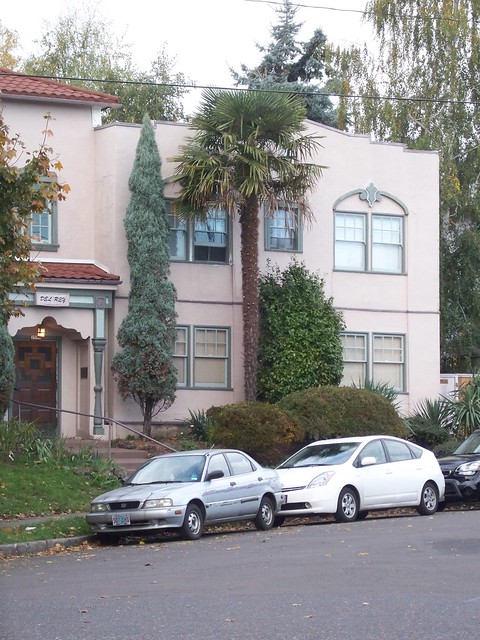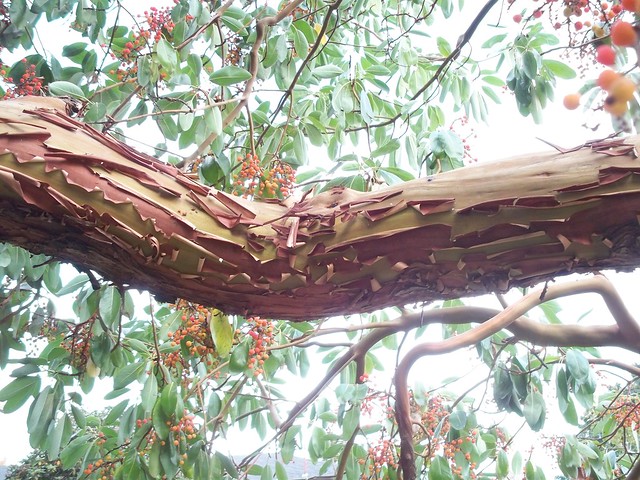 |
| Oh Tom Kiefer, you are so right. |
I've been thinking a bit about the upcoming Palm Tree Ride in January. In the couple months leading up to the ride during my wanderings around town I keep my eyes open for new palm locations. This is how I have found all the palms for the rides I've done over the past seven years. It's also how I find other interesting things around town.
The upcoming Palm Tree Ride is themed "back to our roots". As I've tried to explore different regions of the city after the first two rides, this one will be a return to the palms of the first couple rides. So I've been passing by these palms to make sure that they are still there. For the most part they are. But on Wednesday November 2nd I made a shocking discovery: one of Portland's tallest, if not tallest, palms is no more.
There was a Chinese Windmill palm growing in front of the apartment building at 2525 NE Glisan. I unfortunately don't have a great shot of the palm, but thanks to Google Street View, you can see what it looks like:
View Larger Map
And in case that don't work:
I don't know for sure when this palm was planted, but it's been long enough for it to be as tall as the three story building. The apartment building was built in 1922. I don't think it was planted then (though I think windmill palms can live quite long), but it had been there for awhile. I remember that this particular palm was featured in a Willamette Week "Best of Portland" piece years back and someone mentioned it might have been planted in the 1940s. I can't find that piece (no thanks to Google) and the date they determined was conjecture anyway. It's safe to assume the palm was old.
So I was startled to find out that it was gone.
I wonder what happened. Was the tree sick and old and needed to be cut down? Or did the owner simply decide they didn't want it there anymore? If it's the former, I can understand cutting it down. But if it's the latter, that's a shame.
I know that some people hate palm trees. Too much association with California, and more specifically, Californians. So cutting down the palm could be seen as a "justifiable" act. Let's face it: there are no protected palm trees in Portland. You'll never see one be considered for Heritage Tree status. Palms don't look like they belong here. But how many of Portland's Heritage Trees are actually native to this area? Or most of our street trees? Those lovely trees that we admire, most of them are native to areas east of the Rockies or the Mississippi. How's that for local?
And that spindly windmill palm, clinging on for dear life to the side of that apartment building, was the closest thing to a heritage palm tree we might ever get.*
Let's face it: we're more apt to tear down things from our recent past or things we don't feel belong here than "historic" buildings. But what is historic? Don't we need to preserve some aspects of every era, even if we find it ugly at the time? In the 1950's Portland went to work tearing down block upon block of 19th Century cast-iron buildings. Why? Because they were "ugly" and "old". We lost a great chunk of history. Thankfully in the 1970's the tide changed and preservation was a buzz word. But preservation of things of a certain age. Or of "historic value".
Who determines historic value, anyway? As documented in Dan Haneckow's excellent blog Cafe Unknown Portland just recently down Hotel West where the famed punk club Satyricon was located. While the building itself was not "architectually significant", Satyricon was culturally significant. It was where Kurt met Courtney, for one. But that mattered little in the eyes of the preservationists. So down it went. Twenty years from now, will we look back on this and think that we were foolish?
I was a bit steamed, to say the least.
Thankfully the palm tree just around the corner was still standing.
And I found something else to cheer me up: a madrona tree! I spotted this beauty on NE Everett near 24th.
Now ironically enough madrones are native to this area. They are in fact the only broadleaf evergreen we got native to this part of the Northwest. But you rarely see them around town, because they make bad street or yard trees. Not so much due to the litter of leaves and exfoliating bark but more due to soil. Madronas like well drained soil. That's a reason why they cling to hillsides, and why most of them are found along the bluffs lining the Willamette. Most people don't want to go through the trouble of planting them on their property.
I like including madronas along with other "exotics" as eucalyptus on my Palm Tree Ride. So I lost an old friend and gained a new one for this upcoming tour.
*The palm on SE 22nd and Stephens would be the runner-up.
So I was startled to find out that it was gone.
I wonder what happened. Was the tree sick and old and needed to be cut down? Or did the owner simply decide they didn't want it there anymore? If it's the former, I can understand cutting it down. But if it's the latter, that's a shame.
I know that some people hate palm trees. Too much association with California, and more specifically, Californians. So cutting down the palm could be seen as a "justifiable" act. Let's face it: there are no protected palm trees in Portland. You'll never see one be considered for Heritage Tree status. Palms don't look like they belong here. But how many of Portland's Heritage Trees are actually native to this area? Or most of our street trees? Those lovely trees that we admire, most of them are native to areas east of the Rockies or the Mississippi. How's that for local?
And that spindly windmill palm, clinging on for dear life to the side of that apartment building, was the closest thing to a heritage palm tree we might ever get.*
Let's face it: we're more apt to tear down things from our recent past or things we don't feel belong here than "historic" buildings. But what is historic? Don't we need to preserve some aspects of every era, even if we find it ugly at the time? In the 1950's Portland went to work tearing down block upon block of 19th Century cast-iron buildings. Why? Because they were "ugly" and "old". We lost a great chunk of history. Thankfully in the 1970's the tide changed and preservation was a buzz word. But preservation of things of a certain age. Or of "historic value".
Who determines historic value, anyway? As documented in Dan Haneckow's excellent blog Cafe Unknown Portland just recently down Hotel West where the famed punk club Satyricon was located. While the building itself was not "architectually significant", Satyricon was culturally significant. It was where Kurt met Courtney, for one. But that mattered little in the eyes of the preservationists. So down it went. Twenty years from now, will we look back on this and think that we were foolish?
I was a bit steamed, to say the least.
Thankfully the palm tree just around the corner was still standing.
 |
| I think the palm compliments the Del Ray Apartments quite well. |
And I found something else to cheer me up: a madrona tree! I spotted this beauty on NE Everett near 24th.
 |
| Love the exfoliating bark! |
Now ironically enough madrones are native to this area. They are in fact the only broadleaf evergreen we got native to this part of the Northwest. But you rarely see them around town, because they make bad street or yard trees. Not so much due to the litter of leaves and exfoliating bark but more due to soil. Madronas like well drained soil. That's a reason why they cling to hillsides, and why most of them are found along the bluffs lining the Willamette. Most people don't want to go through the trouble of planting them on their property.
I like including madronas along with other "exotics" as eucalyptus on my Palm Tree Ride. So I lost an old friend and gained a new one for this upcoming tour.
*The palm on SE 22nd and Stephens would be the runner-up.




No comments:
Post a Comment
I'm no longer allowing new comments on this blog. You can comment on the exact same post on the new blog. Go find it over at http://urbanadventureleague.wordpress.com/
Note: Only a member of this blog may post a comment.